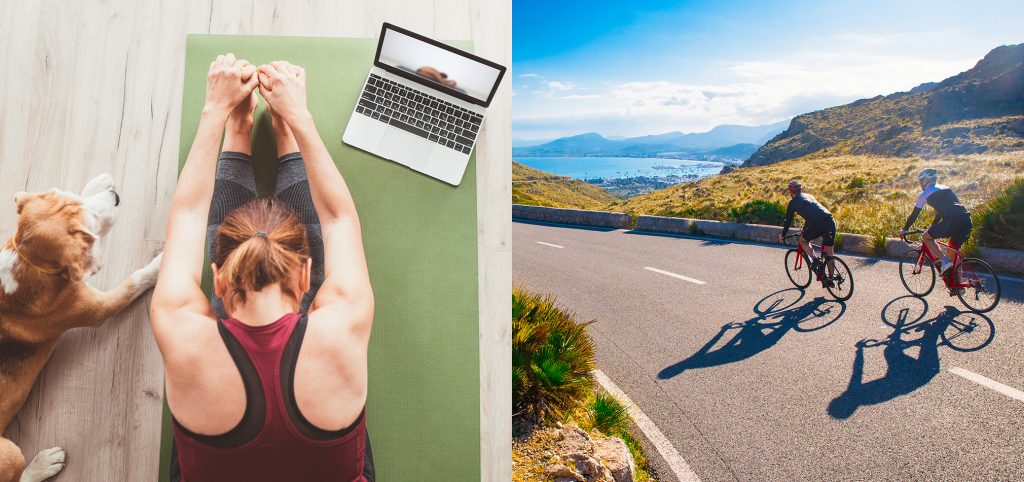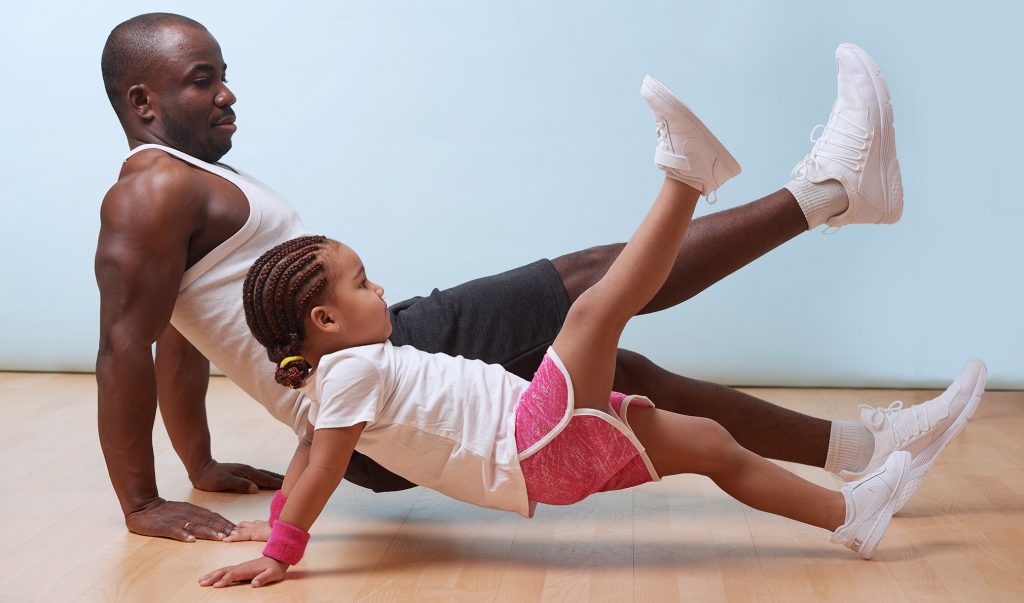Simple Ways to Fit Fitness Into Your Busy Life
Today’s hectic lifestyle can make it difficult to carve out time for fitness. Long workdays, never-ending to-do lists and family commitments can all conspire to keep you from getting the physical activity you need. And in the era of COVID-19, finding ways to exercise can be even more difficult, especially if your gym is in lockdown mode.


Simple Ways to Fit Fitness Into Your Busy Life
January 7, 2021
.
Today’s hectic lifestyle can make it difficult to carve out time for fitness. Long workdays, never-ending to-do lists and family commitments can all conspire to keep you from getting the physical activity you need. And in the era of COVID-19, finding ways to exercise can be even more difficult, especially if your gym is in lockdown mode.
Yet it’s important to find time for regular exercise, not only for your physical health, but for your mental and emotional health as well. Whether it’s a quick jog with your pooch before work, a weight workout during your lunch break or a hearty game of tag with your kids, there are any number of ways to keep yourself physically active.
Need more ideas? Try our simple and effective tips to help you get the exercise you need.
What Experts Say You Need
The Office of Disease Prevention and Health Promotion (ODPHP) at the U.S. Department of Health and Human Services recommends that adults do two types of exercise regularly: aerobic activity (such as swimming, cycling or brisk walking) and muscle-strengthening exercises (push-ups or lifting weights, for example). Experts at the ODPHP advise a minimum of 150 to 300 minutes of moderate- to vigorous-intensity aerobic exercise each week, in addition to at least two days of muscle-strengthening exercises weekly.1
While guidelines used to recommend trying to get at least 10 minutes of activity at a time, the ODPHP now says that any amount helps your health. So if you can’t get, say, 30 minutes of exercise in one spurt, aim to increase the amount of exercise you get throughout the day. In other words, aim to move more and sit less.

How to Fit Exercise Into Your Busy Day
Remember, the benefits of exercise are cumulative, so any bit of physical activity you can work into your day counts. Here are some ways to fit more exercise in.
1. Become an early riser.
It can be tough to get out of your warm bed at oh-dark-thirty, especially if it’s cold and dreary out. But there’s some pleasure in greeting the sun while getting your sweat on — and you will adjust to it, we promise! There’s also an element of solitude you may come to enjoy in the early-morning quiet, especially if it’s lacking during your hectic days. As an added benefit, getting a good dose of cardio in the morning may help you sleep better at night, the Sleep Foundation reports.2
2. Grab some exercise at work.
Leave a pair of athletic shoes at the office (or within easy reach if you’re working from home) and head out for a brisk, arm-pumping walk at lunchtime. Not only will it add to your exercise total, but it can help with workday stress. In fact, a 2018 study showed that participating in just 15 minutes of what researchers referred to as relaxation exercise during the workday, such as taking a walk in a park, brings a greater sense of well-being at the end of the day.3
Other ideas for sneaking exercise into your workday:
- Try “walk and talks.” If you’ve got an informal meeting or need to do some brainstorming, throw on your athletic shoes and take a brisk walk with your co-workers while you hash out what you need to work on.
- Take the stairs This tried-and-true technique really helps with your aerobic fitness. Plus stairs work a number of muscles, including the quads, glutes, hamstrings and core.
- Get up and move. Try to take a quick break every hour. Walk to the water cooler, use the restroom, stroll around the office, do some squats at your desk. For extra stress relief, do some arm circles and shoulder shrugs while you’re walking.
- Leave a pair of dumbbells at work. Got a long phone call? Do some standing shoulder shrugs, bicep curls, tricep extensions and wrist curls while you’re on your call. (A headset may prove helpful here.)
- Is there a gym at work? Use it! If your employer offers workout equipment or exercise classes on site, take advantage of them! Try eating lunch at your desk, then spend your break exercising. Or if it’s too difficult to fit in a workout during the day, come in early or stay late to get some exercise in. It’ll do your body — and mind — good.
- Got access to a standing desk? Give it a shot. While working while standing isn’t technically exercise, it does help you sit less — which is important for your health, as the new guidelines state. According to the ODPHP, research has shown a strong correlation between sedentary behavior and a number of health conditions, including heart disease and high blood pressure. And Harvard Health reports that using a standing desk brings other potential benefits as well, including a faster return to normal blood-sugar levels after meals and a reduced risk of shoulder and back pain.4



.
3. Still commuting? Find ways to work around it.
If you’re working in an office and contending with a long commute, your workout time can seriously suffer. To help offset the hours spent in travel, carve out time to do some type of exercise during your workday, as mentioned above. Or, if you take the bus or train, try walking or biking to and from the station, or parking farther away and walking to the depot. Bonus points for bringing some weights and using them on the train or bus.
4. Take a walk after dinner.
Think like an Italian and take a passeggiata — a leisurely walk, taken for pleasure — after dinner. There’s no need to work up a sweat; just use the time to relax and move your body. In fact, you may not want to exercise too vigorously too close to bed, as the Sleep Foundation reports that doing so can interfere with sleep for some people.2
5. Do some gentle yoga before bed.
According to the National Center for Complementary and Integrative Health at the U.S. Department of Health and Human Services, yoga has a host of potential benefits. Research has shown that it may improve sleep; relieve stress; improve mental and emotional health, including reducing the anxiety and depression caused by difficult life situations; improve low-back and neck pain; improve symptoms of menopause; and more.5
6. Keep the end goal in mind: better health.
If you’re having a hard time making the commitment to getting more workout time in, remember the many benefits that exercise provides:
- Immediate health benefits, such as reduced blood pressure and anxiety and improved sleep and insulin sensitivity
- Longer-term benefits, including that it helps prevent cancer of the bladder, breast, colon, endometrium, esophagus, kidney, stomach and lungs; reduces the risk of dementia; lowers the risk of depression, heart disease, high blood pressure, stroke and Type 2 diabetes; improves bone health, overall physical function and quality of life; and helps prevent weight gain
Exercise can also help prevent postpartum depression in pregnant women. And it helps with the management of chronic health conditions, such as high blood pressure, osteoarthritis, Type 2 diabetes, anxiety and depression.1
We hope these tips have given you inspiration to fit some all-important exercise into your life. Not only do you need it — you deserve it!
Footnotes:
1 “Top 10 Things to Know About the Second Edition of the Physical Activity Guidelines for Americans” Health.Gov. https://health.gov/our-work/physical-activity/current-guidelines/top-10-things-know. Accessed Dec. 2020.
2 “How the Timing of Your Workout Schedule Can Help Your Sleep Quality.” Sleep Foundation, https://www.sleepfoundation.org/physical-activity/best-time-of-day-to-exercise-for-sleep. Accessed Dec. 2020.
3 “Sianoja, Marjaana, et al. “Enhancing Daily Well-Being at Work Through Lunchtime Park Walks and Relaxation Exercises: Recovery Experiences as Mediators.” Journal of Occupational Health Psychology, vol. 23, no. 3, July 2018, pp. 428–42. PubMed, doi:10.1037/ocp0000083.
4 MD, Robert H. Shmerling. “The Truth Behind Standing Desks.” Harvard Health Blog, 23 Sept. 2016, https://www.health.harvard.edu/blog/the-truth-behind-standing-desks-2016092310264.
5 “Yoga: What You Need To Know.” NCCIH, https://www.nccih.nih.gov/health/yoga-what-you-need-to-know. Accessed Dec. 2020.
Featured Profile
Our new 'The Point of Care Campaign' is our way of showing appreciation to healthcare workers during COVID. Our profile this week features Diana Hernandez.
Related Articles
Introducing the HemoCue Customer Portal

